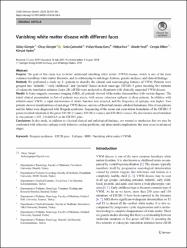| dc.contributor.author | Güngör, Gülay | |
| dc.contributor.author | Güngör, Olcay | |
| dc.contributor.author | Çakmaklı, Seda | |
| dc.contributor.author | Maraş Genç, Hülya | |
| dc.contributor.author | İnce, Hülya | |
| dc.contributor.author | Yeşil, Gözde | |
| dc.contributor.author | Dilber, Cengiz | |
| dc.contributor.author | Aydın, Kürşad | |
| dc.date.accessioned | 2019-12-26T07:31:09Z | |
| dc.date.available | 2019-12-26T07:31:09Z | |
| dc.date.issued | 2020 | en_US |
| dc.identifier.citation | Güngör, G., Güngör, O., Çakmaklı, S., Maraş Genç, H., İnce, H., Yeşil, G. ... Aydın, K. (2020). Vanishing white matter disease with different faces. Child's Nervous System, 36(2), 353-361. https://doi.org/10.1007/s00381-019-04334-6 | en_US |
| dc.identifier.issn | 0256-7040 | |
| dc.identifier.issn | 1433-0350 | |
| dc.identifier.uri | https://doi.org/10.1007/s00381-019-04334-6 | |
| dc.identifier.uri | https://hdl.handle.net/20.500.12511/4714 | |
| dc.description.abstract | Purpose: The goal of this study was to better understand vanishing white matter (VWM) disease, which is one of the most common hereditary white matter disorders, and its relationship to radiologic features, genetic analyses, and clinical findings. Methods: We performed a study on 11 patients to describe the clinical and neuroimaging features of VWM. Patients were grouped into “infantile,” “early childhood,” and “juvenile” based on their onset age. EIF2B1–5 genes encoding five subunits of eukaryotic translation initiation factor 2B (eIF2B) were analyzed in all patients with clinically suspected VWM disease. Results: In brain magnetic resonance imaging (MRI), all patients showed white matter abnormalities with various degrees. The initial clinical presentation in five of patients was ataxia, with severe refractory epilepsy in three patients. In children with infantile-onset VWM, a rapid deterioration of motor function was detected, and the frequency of epilepsy was higher. Two patients showed manifestations of end-stage VWM disease, and one of them had chronic subdural hematoma. One of our patients and his father were diagnosed with Brugada syndrome. Sequencing of the exons and exon-intron boundaries of the EIF2B1–5 genes revealed mutations in the genes EIF2B5 (5 cases), EIF2B3 (3 cases), and EIF2B4 (2 cases). We also found a novel mutation in one patient: c.323_325delGAA in the EIF2B1 gene. Conclusions: In this study, in addition to classical clinical and radiological findings, we wanted to emphasize that we may be confronted with refractory epilepsy (early infancy), cardiac problems, and intracranial complications that may occur in advanced stages. | en_US |
| dc.language.iso | eng | en_US |
| dc.publisher | Springer | en_US |
| dc.rights | info:eu-repo/semantics/openAccess | en_US |
| dc.subject | Brugada Syndrome | en_US |
| dc.subject | EIF2B Gene | en_US |
| dc.subject | Epilepsy | en_US |
| dc.subject | MRI | en_US |
| dc.subject | Vanishing White Matter (VWM) | en_US |
| dc.title | Vanishing white matter disease with different faces | en_US |
| dc.type | article | en_US |
| dc.relation.ispartof | Child's Nervous System | en_US |
| dc.department | İstanbul Medipol Üniversitesi, Tıp Fakültesi, Dahili Tıp Bilimleri Bölümü, Çocuk Sağlığı ve Hastalıkları Ana Bilim Dalı | en_US |
| dc.identifier.volume | 36 | en_US |
| dc.identifier.issue | 2 | en_US |
| dc.identifier.startpage | 353 | en_US |
| dc.identifier.endpage | 361 | en_US |
| dc.relation.publicationcategory | Makale - Uluslararası Hakemli Dergi - Kurum Öğretim Elemanı | en_US |
| dc.identifier.doi | 10.1007/s00381-019-04334-6 | en_US |
| dc.identifier.wosquality | Q4 | en_US |
| dc.identifier.scopusquality | Q2 | en_US |


















